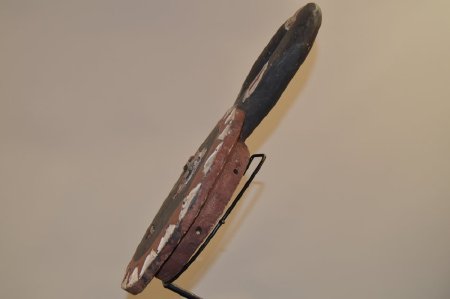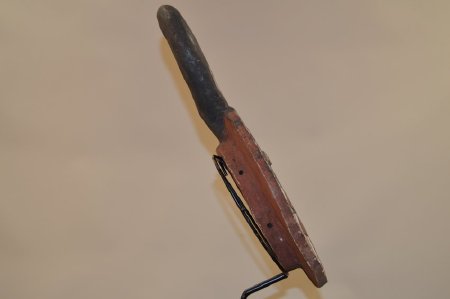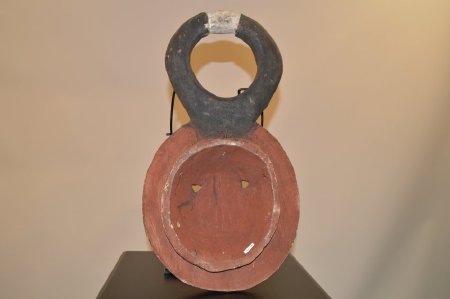Title:
Baoule, Goli Style, Kplekple Mask
Object Name:
Mask, Dance, Ritual
Other Name:
Mask, Baoule, Goli Style, Kplekple
Place of Origin:
Baoule, Ivory Coast, Africa
Provenance:
Aboriginal Indigenous Art.
Masks correspond to several types of dances: the gba gba, the bonu amuen, the mblo and the goli. They never represent the ancestors and are always worn by men. The gba gba is used at the funerals of women during the harvest season. It celebrates beauty and age, hence its refined features. The double mask represents the marriage of the sun and the moon or twins, whose birth is always a good sign. The bonu amuen protects the village from external threats; it obliges the woman to a certain discipline; and it appears at the commemorations of death of notables. When they intervene in the life of the community, they take the shape of a wooden helmet that represents a buffalo or antelope and which is worn with a raffia costume and metal ankle bracelets; the muzzle has teeth, which incarnate the fierce animal that is to defend the group.
Goli is the day—long spectacle that normally involves the whole village and includes the appearance of four pairs of masks, music played on special instruments, and, ideally, the jojoyous consumption of a great deal of palm wine. Goli can be performed both as an entertainment and for the funeral of important men. The very characteristic, round—shaped “lunar” goli is surmounted by two horns. It was borrowed from the Wan for a celebration adopted by the Baule after 1900. Celebrating peace and joy, they would sing, dance, and drink palm wine. In the procession, the goli preceded the four groups of dancers, representing young adolescents. The goli would be used on the occasion of the new harvest, the visit of dignitaries, or at the
funerals of notables.
The goli kplekple mask is one of several that appear in the Goli spirit dance. It represents a minor spirIt associated with the junior rank of male dancers who perform before the more important masks appear. In keeping with its low status, this mask is made in a simple disk—shaped design and lacks the more complex form and ornamentation that the Baule admire in their important masks. Considered a mischievous mask, the youthful dancer playfully chases young women around the village, goaded by their songs.
Masks correspond to several types of dances: the gba gba, the bonu amuen, the mblo and the goli. They never represent the ancestors and are always worn by men. The gba gba is used at the funerals of women during the harvest season. It celebrates beauty and age, hence its refined features. The double mask represents the marriage of the sun and the moon or twins, whose birth is always a good sign. The bonu amuen protects the village from external threats; it obliges the woman to a certain discipline; and it appears at the commemorations of death of notables. When they intervene in the life of the community, they take the shape of a wooden helmet that represents a buffalo or antelope and which is worn with a raffia costume and metal ankle bracelets; the muzzle has teeth, which incarnate the fierce animal that is to defend the group.
Goli is the day—long spectacle that normally involves the whole village and includes the appearance of four pairs of masks, music played on special instruments, and, ideally, the jojoyous consumption of a great deal of palm wine. Goli can be performed both as an entertainment and for the funeral of important men. The very characteristic, round—shaped “lunar” goli is surmounted by two horns. It was borrowed from the Wan for a celebration adopted by the Baule after 1900. Celebrating peace and joy, they would sing, dance, and drink palm wine. In the procession, the goli preceded the four groups of dancers, representing young adolescents. The goli would be used on the occasion of the new harvest, the visit of dignitaries, or at the
funerals of notables.
The goli kplekple mask is one of several that appear in the Goli spirit dance. It represents a minor spirIt associated with the junior rank of male dancers who perform before the more important masks appear. In keeping with its low status, this mask is made in a simple disk—shaped design and lacks the more complex form and ornamentation that the Baule admire in their important masks. Considered a mischievous mask, the youthful dancer playfully chases young women around the village, goaded by their songs.
Description:
Circular or disk—shaped wooden mask, with large inverted teardrop—shaped eyes, outlined by white and red paint, black centers and holes in the lower center areas. Black circular interior, with crescent—shaped mouth and white teeth. White and red border around outer exterior of mask in an alternating triangular pattern. Black circular horns erupting top of mask, connecting and painted white in top center area. White oval—shaped circles with red interiors painted on either side of lower horns.
Collection:
Guy Mace Collection, (Turblex Company)
Material:
Wood W/Paint
Used:
Ritually Used
Technique:
Carving / Painting
Owned:
Art Department, Missouri Southern State University
Accession#:
2015.2.41



